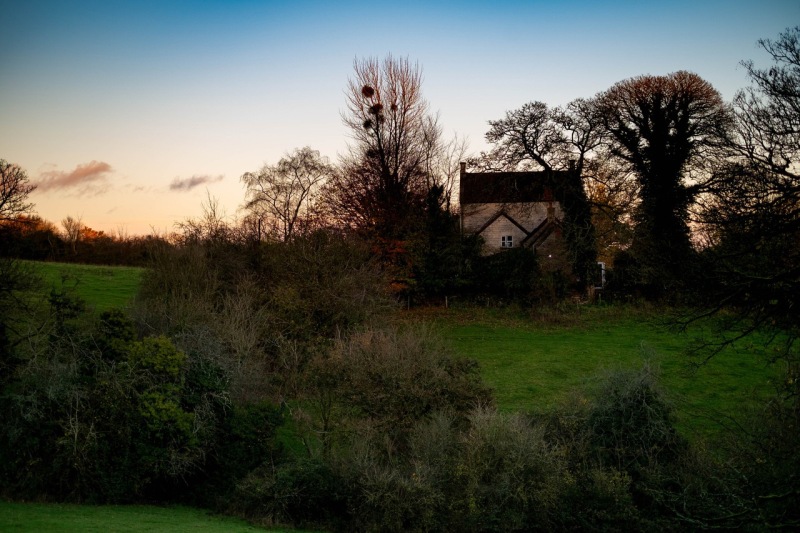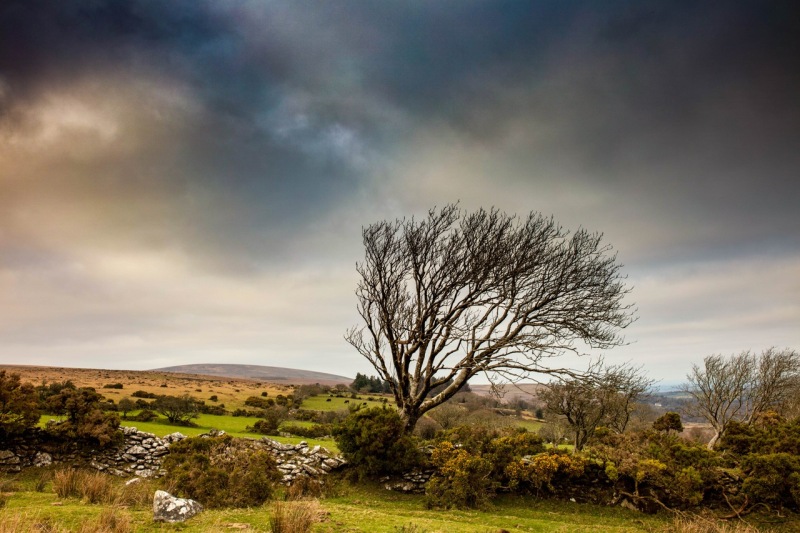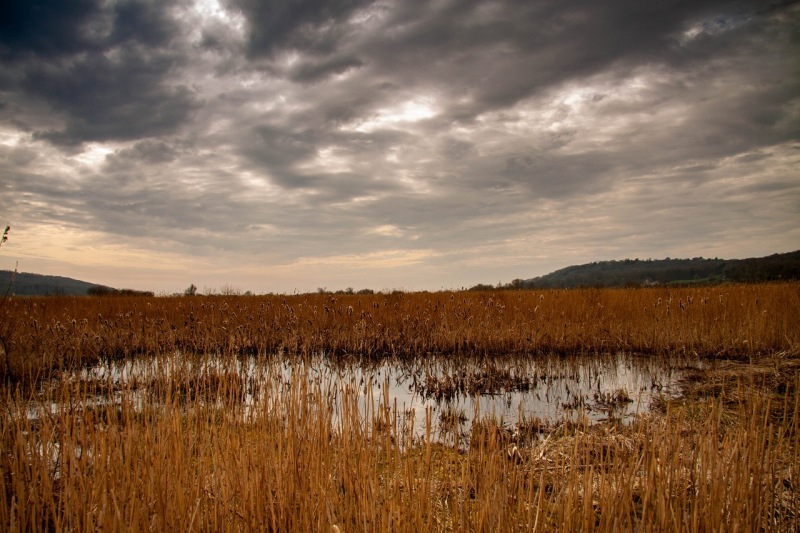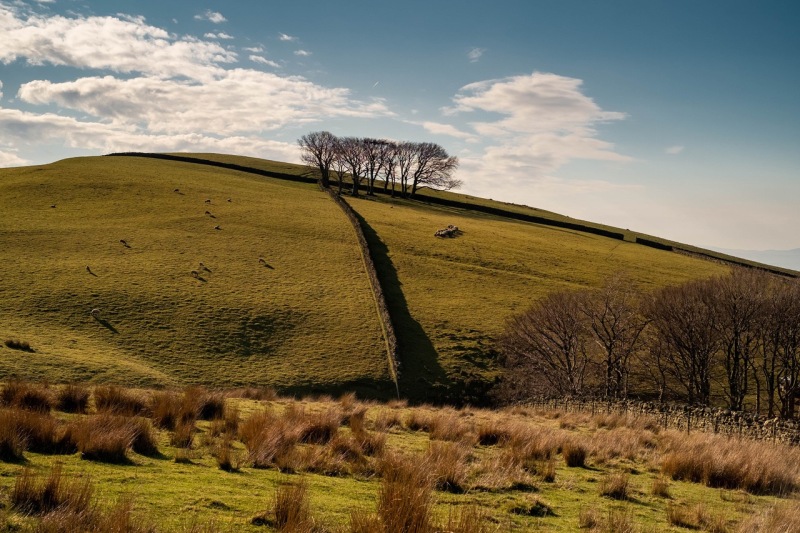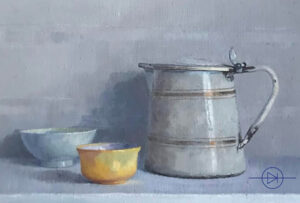Helena Nelson reviews Camera Obscura by Philip Rush (Garlic Press, 2023)
“And what is the use of a book,” Alice famously observed (before her adventures in Wonderland got going), “without pictures or conversations?” She would have found most volumes of contemporary poetry hopeless. But not, perhaps, this one. Here, a modest complement of thirty-four poems is illuminated by nineteen panoramic photographs, all taken by the author. Beautiful images, to my eye – full-colour, mostly landscapes with fabulous skies; often with a track or a fence disappearing uphill and inviting the eye to follow.
Photographs mean you approach a collection in a different way. They demand your attention first (text is more patient). A gorgeously crepuscular picture appears opposite the third poem. I lingered there and feasted. There’s another one opposite poem four, another for poem five. Then no fewer than eight text pages before the next picture. I confess I was hankering for a colour fix by poem seven, though that pleasure was deferred until poem eleven.
Why include photographs at all? It’s easier to explain why not. Most poetry books are fairly short, monochrome, and therefore cheap to print. So this full-colour item (cover price £10) was more costly to produce than most. The print run was probably small, but the unit cost (albeit not reflected in the cover price) will have been high. Garlic Press owner / editor Michael Laskey clearly values the character of the book more than its cost / return ratio, a special feature of very small presses. Charles Boyle recently observed in his CB Editions newsletter (June 2024): “The figures for the last financial year (and the year before, and before) show a net loss. A tolerable loss, for now; probably less than what my neighbours spend on their summer holidays.” Interestingly, Camera Obscura author, Philip Rush, himself runs Yew Tree Press, which lists two illustrated pamphlets as new publications. It’s reasonable, isn’t it, for a poet / photographer / artist to want to combine different aspects of their work? Less usual, perhaps, to make it happen.
The truth is, I came to Camera Obscura for the poems, not for the photographs. Nevertheless, as an added extra, I was pleased to meet them. Reflecting on the relationship between poem and camera was one of the added pleasures of an unusually pleasurable read. For example, on page 46, a photo of the National Trust’s Stowe Gardens features a landscaped lawn, sundry trees, a scattered gaggle of Canada geese (I think) and a small circular temple-type building. It’s probably Capability Brown shaping the garden to resemble a classical painting – maybe by Claude Lorrain. But Lorrain would have ensured a bit of human interest, whereas here it’s conspicuous by its absence. Except that the facing poem, ‘Landscape with Dancing’ is all about that absence:
Goddesses
are thin
on the ground
these days
and as for nymphs,
satyrs,
shepherds
and shepherdesses,
or heroes
from forgotten epics,
you can’t get
hold
of the likes
of that lot,
not for love
nor money.
You can see immediately how the short lines and indents pace the reader’s progress, ensuring that the end of the sentence arrives with full impact. A sweet especial rural scene meets Del Boy from Only Fools and Horses. And I, who would ordinarily have raised an eyebrow at those indented fragmentary lines, found myself savouring them. The poem is an entertainment: graceful, well-paced, gently amusing. It works perfectly with the accompanying photograph.
The poem is an entertainment: graceful, well-paced, gently amusing. It works perfectly with the accompanying photograph
You can also see from the previous quotation that the predominant style is conversational. So Alice would have found pictures and conversations in this volume. In fact, any reader (including those wary of Poetry) could find things to enjoy here. There are even jokes. The poem ‘Mini Cooper S’, for example (bearing in mind the poet’s surname), has elements of stand-up:
My father said to me once
and he was right,
‘Never make a joke
out of anyone’s name.’
But I’m the guy
who went to school
on London Transport Buses
whose posters
exhorted everyone
to ‘Avoid the Rush’.
I worked my way through the whole book merrily and quickly. But then it drew me back. Each time I re-read a poem I hadn’t really noticed before, the pleasure increased. I was puzzled to explain why I was liking it so much. I don’t usually relish a mixture of text and photograph. Anyway, not all the poems have pictures. Besides, inside the poems themselves, the poet uses techniques I’m not keen on. That preceding quotation from ‘Mini Cooper S’, for example – ordinarily I might regard the short lines as controlling (I hate poets chopping phrases into neat chunks). Yet here, like Goldilocks, I felt the porridge was just right. What was going on?
The poet worked his persuasive trick even with a form I actively dislike! The opening piece (no picture), ‘How to Get to Summer’, follows the ‘how to’ method. You know the kind of thing I mean. A series of instructions leading to a high point. This one starts: “Draw up lists. Print out in full / the reservations you’ve made on line.” But it’s not like all the others. Somehow it shifts the didactic tone sideways. Somehow it mocks its own good advice: “Don’t be afraid of getting lost. / Knowing where you are is an illusion / which is expensive to maintain.” Somehow it demonstrates how not to end a poem on a high point. In fact, Philip Rush may be a master of anti-climax.
Either way, epiphany is something he is deliberately not doing. He doesn’t do big themes. He doesn’t do grand gestures. He writes with minimal fuss, often about not much. That sounds dismissive, but it’s not. It’s all our lives. It doesn’t get more universal than that. ‘Island’ (which has two pictures) doesn’t even tell you its location. It starts, vaguely “A ferry holds something at bay.” What? Who could possibly recommend “A ferry holds something at bay” as a starting line? How on earth can it work? Because it does. It does work, and I don’t know why. When the poet reaches stanza three (“We arrive as strangers / unsure of which direction to take”), he might just as well be describing the readers of the poem. Where are we going with all this? No idea. Why do we go along with it? Good question. Because we don’t even arrive. Here’s the last stanza:
The autumn show is being packed away
beneath hot sun.
The woman in the shop sells postcards,
home-made ginger biscuits
and decent coffee
to be enjoyed at the water’s edge.
This is so odd. No uplift, no profundity, no insight, no assonance, not one touch of alliteration. Just a cup of decent coffee and a biscuit. I feel I know how it was that day, though. I’ve been to that island, wherever it is or isn’t. Maybe it’s all about mood.
One poem – ‘Think Tank Thug’ – employs the sort of exaggeratedly long lines and prosy style that always make me sigh and turn to the next page. Not here. Here, I love it. I find it so delightful and so clever that I can’t bring myself to write about the poem or quote an extract – although I long to introduce you to “the strong verbs” drinking in the pub. If you were here, I would make you sit down and listen to me reading it aloud. Possibly twice.
So what is the secret? It’s partly character. It’s the personality of Philip Rush, whoever and whatever he is (I don’t know him). He’s quirky, funny, thoughtful, entertaining. He doesn’t show off
So what is the secret? It’s partly character. It’s the personality of Philip Rush, whoever and whatever he is (I don’t know him). He’s quirky, funny, thoughtful, entertaining. He doesn’t show off. He shares what feels like the perfect phrase, or word, or expression for the context, as though he’d picked it up while walking in the woods. The writing’s mainly rooted in the natural world where everything is as ordinary (and as miraculous) as a leaf, if you look at it carefully. He does look. And the more you read him, the more you trust him to tell you what he sees.
He pays attention in such an understated way, however, that you could miss it. Only as you revisit, do you marvel at the depth and the spareness. In ‘Quantox’, for example, a woman (she could be me) feels “the comfortable security / of good boots, / the hug of a small rucksack.” That “hug” is as unspectacular as it is satisfying. So is the way the piece concludes:
She stopped to listen
to the stream
and its silences.
As she waited,
a single leaf
dawdled from the sky
and dusk tucked itself
into the steep sides
of the valley.
I don’t think I could have come up with “dawdled” for a falling leaf. But it summoned my instant recognition: I could ‘see’ that moment. Even the idea of listening to the “silences” of the stream, the pauses between splashes, the word “tucked” for the dusk, the assonance of “dusk tucked itself” – and each of these details coming together at the end of the day, at the end of the page. Again, perhaps the magic has something to do with mood. If so, I still don’t know quite how he does it.
One of the shortest poems, ‘High Dam’, has only nine short lines. Thirty-two words. It’s a string of pearls. Each complements (and compliments) the next. Not one fancy expression in the whole thing, mostly monosyllables. Any one stanza could stand as its own haiku, although all three connect, have synergy, and shine. I think I’ll print it out, stick it onto a card and keep it on my desk ready for autumn. The final stanza is:
I count the years
in acorns
like a prisoner.
Helena Nelson is a poet, critic and founding publisher / editor of HappenStance Press. She’s also Consulting Editor for The Friday Poem. Her first collection, Starlight on Water (Rialto, 2003), was a Jerwood / Aldeburgh First Collection winner. Her second was Plot and Counterplot (Shoestring, 2010). She also writes and publishes light verse, including Down With Poetry! (HappenStance, 2016) and Branded (Red Squirrel, 2019). Her most recent collection is PEARLS: The Complete Mr & Mrs Philpott Poems (HappenStance, 2022).

